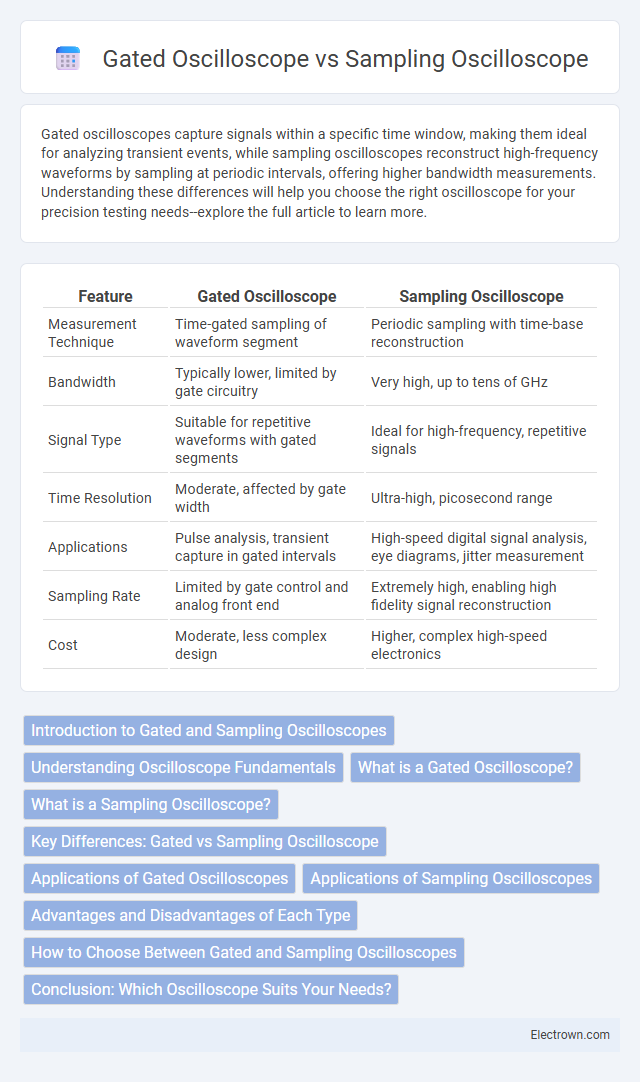Gated oscilloscopes capture signals within a specific time window, making them ideal for analyzing transient events, while sampling oscilloscopes reconstruct high-frequency waveforms by sampling at periodic intervals, offering higher bandwidth measurements. Understanding these differences will help you choose the right oscilloscope for your precision testing needs--explore the full article to learn more.
Table of Comparison
| Feature | Gated Oscilloscope | Sampling Oscilloscope |
|---|---|---|
| Measurement Technique | Time-gated sampling of waveform segment | Periodic sampling with time-base reconstruction |
| Bandwidth | Typically lower, limited by gate circuitry | Very high, up to tens of GHz |
| Signal Type | Suitable for repetitive waveforms with gated segments | Ideal for high-frequency, repetitive signals |
| Time Resolution | Moderate, affected by gate width | Ultra-high, picosecond range |
| Applications | Pulse analysis, transient capture in gated intervals | High-speed digital signal analysis, eye diagrams, jitter measurement |
| Sampling Rate | Limited by gate control and analog front end | Extremely high, enabling high fidelity signal reconstruction |
| Cost | Moderate, less complex design | Higher, complex high-speed electronics |
Introduction to Gated and Sampling Oscilloscopes
Gated oscilloscopes capture and display signal waveforms within a specific time window, enabling detailed analysis of transient events by isolating precise signal segments. Sampling oscilloscopes reconstruct high-frequency waveforms by periodically sampling the signal at discrete intervals, allowing measurement of signals with frequencies beyond the bandwidth of conventional oscilloscopes. Both instruments are essential for analyzing high-speed digital and RF signals, with gated oscilloscopes excelling in time-domain isolation and sampling oscilloscopes providing high-resolution frequency-domain insights.
Understanding Oscilloscope Fundamentals
A Gated Oscilloscope captures specific signal portions by enabling the display only during selected time windows, enhancing analysis of transient events. Sampling Oscilloscopes reconstruct high-frequency signals by sampling at repetitive intervals, enabling detailed observation of fast, repetitive waveforms beyond analog bandwidth limits. Understanding these fundamental differences is key to selecting the appropriate tool for precise time-domain signal characterization in advanced electronic measurements.
What is a Gated Oscilloscope?
A gated oscilloscope is a type of oscilloscope designed to capture and display specific portions of a repetitive signal by using a timing gate to isolate short intervals for detailed analysis. Unlike a sampling oscilloscope, which reconstructs high-frequency signals by sampling points over multiple cycles, the gated oscilloscope provides real-time waveform observation within the selected gate window. Your measurement accuracy improves when using a gated oscilloscope to examine transient or noise signals that occur only during specific time periods.
What is a Sampling Oscilloscope?
A Sampling Oscilloscope is a specialized electronic test instrument designed to measure and visualize high-frequency signals by capturing discrete samples over time, enabling the reconstruction of waveforms that exceed the bandwidth of traditional oscilloscopes. It operates by sampling the input signal at precise intervals, making it ideal for analyzing repetitive signals in applications such as telecommunications and high-speed digital circuits. Unlike Gated Oscilloscopes, which isolate signal segments during certain time windows, Sampling Oscilloscopes achieve higher bandwidth and accuracy by leveraging equivalent-time sampling techniques.
Key Differences: Gated vs Sampling Oscilloscope
Gated oscilloscopes capture signals within a specific time window, making them ideal for analyzing repetitive waveforms and transient events with precise time constraints. Sampling oscilloscopes excel at measuring high-frequency signals by reconstructing waveforms through periodic sampling, providing detailed signal analysis beyond the bandwidth limitations of analog scopes. Your choice depends on the application: gated oscilloscopes suit time-specific signal isolation, while sampling oscilloscopes are better for high-speed, continuous waveform measurement.
Applications of Gated Oscilloscopes
Gated oscilloscopes are essential for analyzing repetitive signals with specific timing requirements, such as in radar systems and digital communication testing. They excel in isolating and displaying waveforms during a particular time window, enabling detailed examination of transient events and glitches. These oscilloscopes are widely used in semiconductor testing, pulse circuit analysis, and timing synchronization verification.
Applications of Sampling Oscilloscopes
Sampling oscilloscopes are widely used in high-frequency and high-speed digital circuit analysis where real-time oscilloscopes face bandwidth limitations. They excel in capturing repetitive signals and analyzing signal integrity in telecommunications, radar systems, and semiconductor testing. Their ability to reconstruct fast transient waveforms with high resolution makes them essential for measuring eye diagrams and jitter in serial data communications.
Advantages and Disadvantages of Each Type
Gated oscilloscopes offer precise time-domain analysis by isolating specific signal segments, providing clear visualization of repetitive signals but struggle with low-frequency or non-repetitive events due to limited sampling windows. Sampling oscilloscopes excel in capturing high-frequency signals by reconstructing waveforms over multiple cycles, enabling detailed analysis of very fast or transient signals yet require repetitive signals and longer acquisition times for accurate waveform construction. Each type's advantages depend on application needs: gated oscilloscopes suit selective waveform viewing, while sampling oscilloscopes are optimal for high-speed signal characterization with repetitive patterns.
How to Choose Between Gated and Sampling Oscilloscopes
Choosing between gated and sampling oscilloscopes depends on the signal frequency, waveform repetition rate, and measurement precision required. Gated oscilloscopes excel in isolating and capturing specific time intervals within repetitive waveforms, making them ideal for time-domain analysis with moderate bandwidths. Sampling oscilloscopes provide higher bandwidths and are better suited for analyzing very high-frequency or non-repetitive signals by reconstructing waveforms from periodic samples.
Conclusion: Which Oscilloscope Suits Your Needs?
A gated oscilloscope excels in capturing and analyzing repetitive or transient signals by isolating specific time intervals, making it ideal for precise waveform examination in digital and communication applications. Sampling oscilloscopes offer superior bandwidth and can measure extremely fast signals by reconstructing waveforms from multiple samples, suited for high-frequency and microwave signal analysis. Choose a gated oscilloscope for detailed time-specific signal study and a sampling oscilloscope when requiring ultra-high-frequency measurements with enhanced resolution.
Gated Oscilloscope vs Sampling Oscilloscope Infographic

 electrown.com
electrown.com